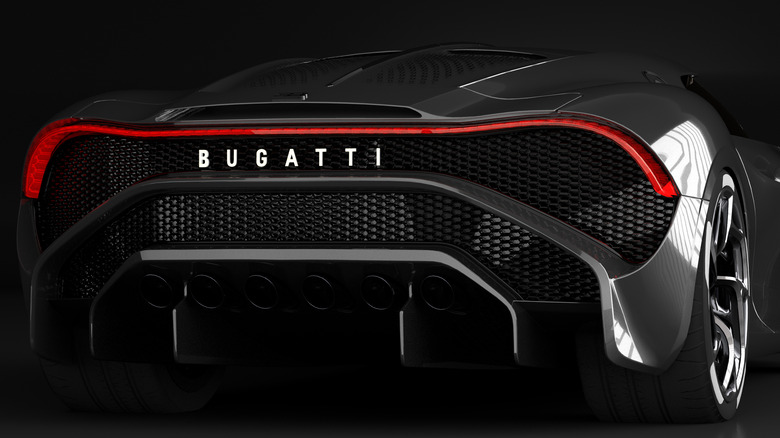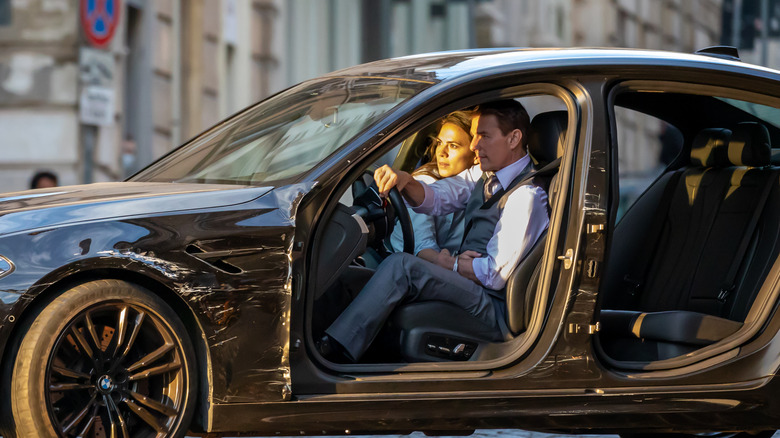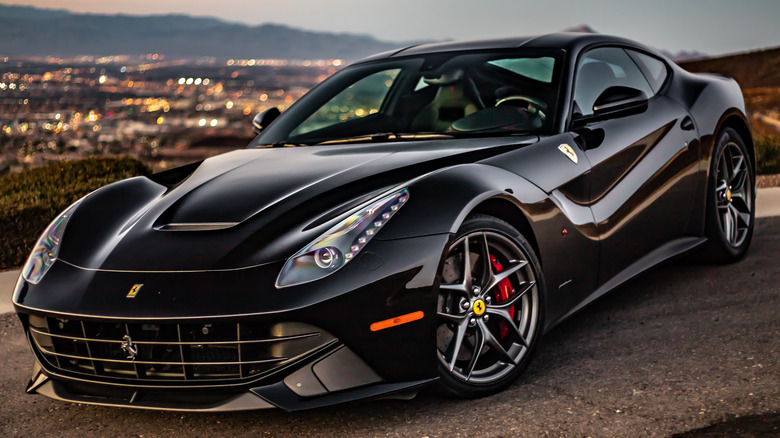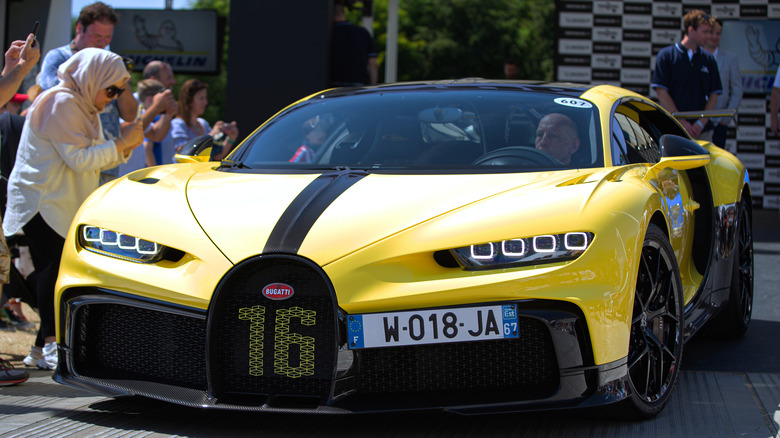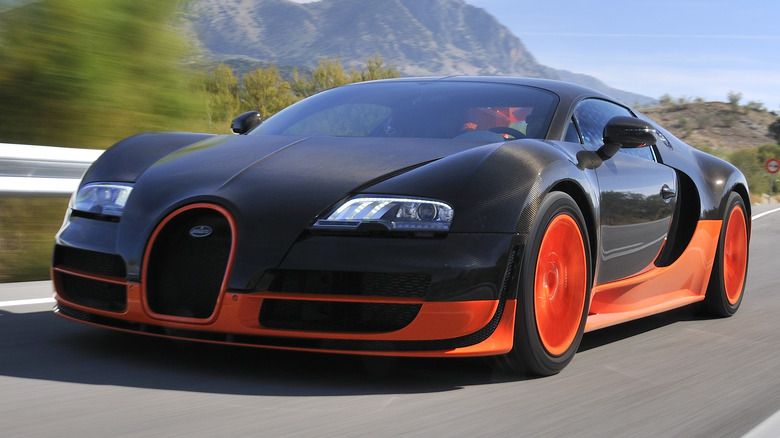Here's Why You Won't See Tom Cruise Driving A Bugatti
Hollywood star Tom Cruise has a stacked portfolio of licenses under his belt, and his collection of rides is no less diverse. In light of that, it is no surprise that he has driven in some of the coolest cars in films throughout his illustrious career. From a slick orange Lamborghini Gallardo and Ducati bikes to a prototype BMW i8, the "Mission Impossible" film series with Cruise in the lead is quite a show of exquisite machines on wheels.
The actor's own personal collection includes classics such as a 1949 Buick Roadmaster and a 1958 Chevrolet Corvette C1, as well as modern machines like a Saleen Mustang and a top-end BMW 7 Series trim (via Motor Biscuit). Given his stature as one of the biggest and most bankable stars Hollywood has ever produced, it is no surprise that any automobile brand would want to associate with him, but it appears that Bugatti is not one of them. In fact, the maker of one of the world's fastest vehicles appears to have banned Cruise from buying its cars, and for a rather odd reason.
What happened between Bugatti and Cruise?
At the premiere of "Mission Impossible 3," Cruise arrived in a swanky Bugatti Veyron, which once held the title of the world's fastest road-legal car. It was quite a statement, but things soon went south. After Cruise got out of the car, he moved to the other side to open the door for his ex-wife Katie Holmes, and it appeared he had little idea how to open the door from the outside. Videos that captured the uncomfortable moment in all its glory have made their way across the internet. After a healthy amount of time fiddling with it, the door finally unlocked.
However, Bugatti was apparently not too happy with one of its finest cars looking bad at the packed premiere of a highly anticipated film. According to a report from Marca, Bugatti subsequently decided to ban Cruise from buying its uber-luxurious cars. As strange as that sounds, the move wasn't unprecedented, and other luxury automakers have similar blacklists for well-known buyers.
It's not only Bugatti that restricts some buyers
Bugatti isn't the only automaker that has a history of distancing itself from certain celebs. Ferrari is another car maker that apparently takes brand image a little too seriously. Take, for example, Canadian musician and DJ Deadmau5, who got into legal trouble with the legendary Italian car company after he gave his Ferrari 458 Italia a generous makeover inspired by the Nyan Cat meme.
The heavy modification included everything from a bright blue coat and license plates to a custom logo and floor mat — the musician even gave it the name "Purrari." Following his legal tussle, Deadmau5 ditched the Ferrari, got himself a Lamborghini Huracan, gave it a similar custom design treatment, and it soon became internet famous by the name "Nyanborghini Purracan" (via Auto Evolution). More recently, Ferrari was again in the spotlight after reportedly putting Justin Bieber and the Kardashian sisters on its blacklist. The pop star apparently displeased the marketing honchos at the company after he treated his own Ferrari to a heavy custom job.
What does a ban actually mean?
As it turns out, banning a celebrity doesn't mean they are legally prevented from buying a certain brand's vehicles. These individuals always have the option of buying one of the cars from a private dealer, shelling out on a used unit, or simply having the vehicle registered under someone else's name while they pay for it. Rather, a ban usually means the blacklisted individuals won't be on the invite list when those companies make a special edition car that will see a few units produced. In Ferrari's case, that could be anything from the F90, a Pininfarina Sergio, or simply a one-off custom model.
While these cars are already expensive, they come with a handful of stipulations such as a minimal degree of customization in order to retain the car's core looks and identity (via Tech Dirt). Moreover, to qualify for a special edition's guest list, one must already have a few machines from that brand in the garage and should be truly enthusiastic about that particular company's cars.
A brief history of the iconic Veyron
The Veyron is arguably the most recognizable car to roll off Bugatti's production line, and it also happens to be one of the most well-known hypercars on the planet. It began with a concept called EB 18/4 Veyron that was revealed at the Tokyo Motor Show in 1999. A slightly modified version dubbed the EB 16/4 made rounds at auto shows in Detroit and Paris, with Volkswagen's W16 engine at its heart.
Two years later, a version that could deliver 1,000 horsepower output was demoed, and it was in 2001 that Bugatti finally decided to push the Veyron into production. Named after company race driver Pierre Veyron, the car's sky-high target specifications — 1,000+ horsepower, top speed of over 248 miles per hour, and hitting 0 to 62 mph in less than three seconds — took another couple of years to go through the engineering challenges. In 2005, the Bugatti Veyron EB 16.4 made its debut rocking a dual-tone design.
In the years that followed, multiple versions of the car were launched. The Grand Sport edition, lacking a roof assembly, arrived in 2008. It was followed by the Super Sport trim, which broke the world record for the fastest production car on the planet after hitting an astonishing 267.8 miles per hour. Two years later, an open-top version called Grand Sport Vitesse hit the roads. A successor, called Bugatti Chiron, finally broke cover in 2016.
